I’m doing two entries for the Historical Sew-Fortnightly ‘Separates’ challenge, and neither of them is the project I had originally planned, and started working on in week 1 of the the fortnight.
However, I’m pretty excited about my first entry, soft as it is, because it is inspired by an image that was shared on the HSF facebook page, and the ensuing discussion.
Sarah posted these knit sleeves from the collection of the Nordiska Museet:
Made of fine wool or silk, they were worn with evening dresses in the chill northern winters, to keep the wearer warm while still being elegant and fashionable, combating the problem of “Dressing in French and freezing in Danish” that Tidens Toj mentions.
I looked at these and thought how perfect they would be to go with my 1813 Kashmiri gown, which, being made of wool, is pretty warm, except for all that exposed arm and chest. There are other examples of similar sleeves or mitts (maybe) in the Nordiska collections, and at the MFA in Boston, indicating that wearing them was reasonably common, and not confined to Scandinavia.
The big problem with these sleeves, for me, is that I don’t knit. So I can’t make a perfect historical replica. The sleeves, were, however, knitted flat, and then had a back seam sewn in to them, and I can get lovely, lacey, merino knit fabrics in white.
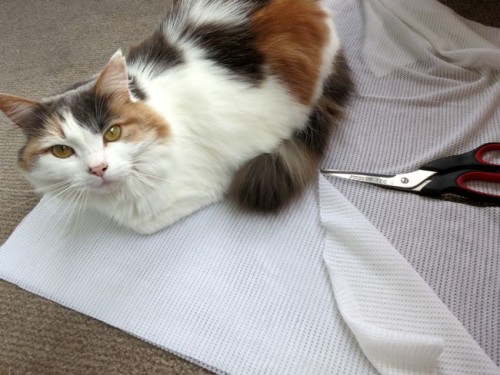
Felicity approves of merino knit. It’s a good fabric. She’s not that interested in letting me make something out of it though.
So I made a pair of merino knit mitts loosely inspired by Regency examples. I originally intended for them to be sleeves, and they started out as sleeves, but they just didn’t want to sit right on my arms, so they got turned into mitts.
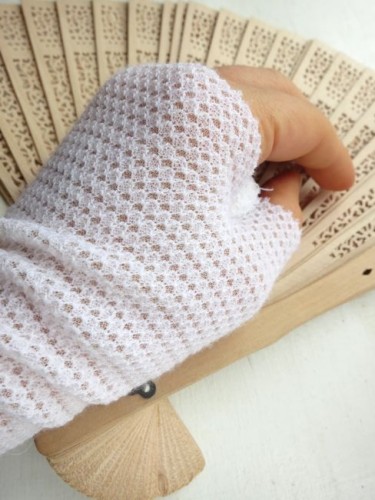
They are super simple: two tubes, shaped slightly to the arm, with triangles sewn in to form thumb holes. I didn’t even finish the top and bottom, because the knit pattern didn’t need it.
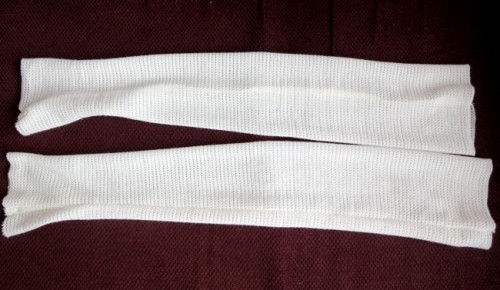
I cut them to go all the way up to the top of my arm, so they will slip under the bottom of the short sleeves of the 1813 Kashmiri gown, and keep me warm all over when I wear it.
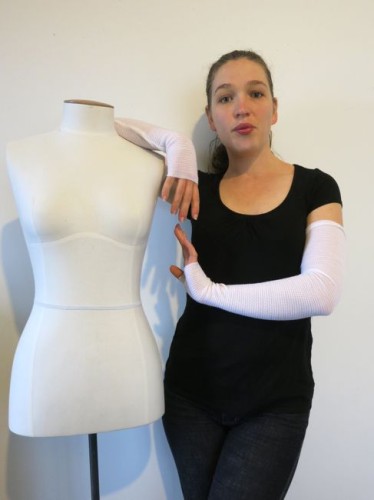
My fabric includes a bit of elastane, so they actually stay up at the top of my arms. I wonder how the originals stayed up. Would they be basted to the sleeves of the dress? Tucked under and expected to stay? Or would the knit provide enough elasticity to stay on its own, which I rather doubt?
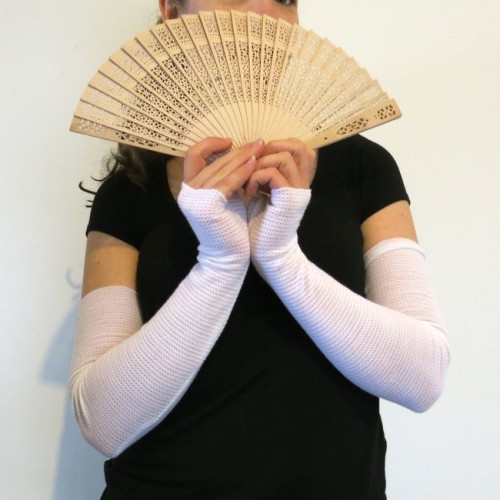
I debated for a tiny instant as to whether these really counted as a separate, rather than just an accessory, but decided that they do: I can wear them with the Kashmiri gown, or the Madame Recamier gown, or any other Regency gown I make in the future, and significantly change the look, and make the dress trans-seasonal.
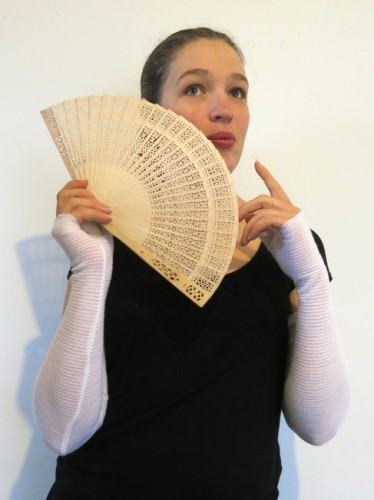
Not only are they going to be perfect with my period wardrobe, but I can tell already that I’m going to make a whole set of them to wear on an everyday basis. Just look how well they work with the Queen Celeste jacket:
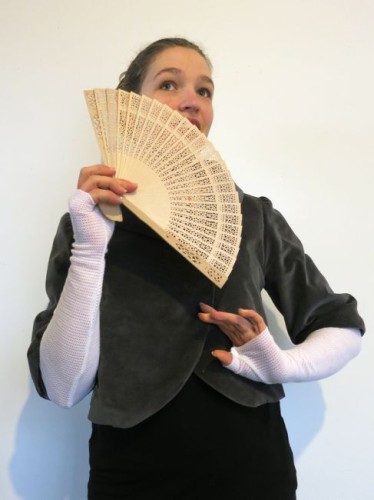
The Challenge: #16 ‘Separates’
Fabric: 1/2 metre of merino/nylon/elastane blend knit, $28pm at 50% off. I can get two pairs out of 1/2 a metre, so $7 a pair.
Pattern: My own, loosely inspired by period examples
Year: ca. 1810
Notions: thread
How historically accurate is it? Not very. More inspired, but I’m not likely to get much more accurate unless I learn to knit. 20% at the best.
Hours to complete: 30 minutes. Best HSF time yet! And now that I have a pattern, I can whip them up in under 10.
First worn: Sat 10 August, while doing other sewing.
Total cost: I can get two pairs out of 1/2 a metre, so $7 a pair.
Hurrah! I’m in love!



Look at those elegant hands! Lovely. 🙂
…Awww … Thanks!
It’s a pity the photos don’t show the mitts all the way to the top, as that would probably answer the question about how they stay up. Two of those pairs seem to be either subtle ribs or lace patterns, and they are both rather more stretchy than plain stocking stitch – so might provide enough elasticity to hold them up. The third pair, which involves cabling and moss stitch, which are less stretchy, seem to have a ribbed section at the end, and I’m thinking they might do at the top as well. That ribbed section would work like the ribbing at the top of your socks, providing extra elasticity and grippiness to hold them up.
But really, you’ve just given me even more reason to desire a knitting machine. I found a stash of them down South, but my husband didn’t seem that keen on letting me buy one…
There are additional photos that do show the mitts all the way to the top. They all have a slight bit of ribbing, but (based on knit socks and mitts I’ve worn) I still don’t think they would stay up without extra help.
Neither do I. But I’m intrigued by the double row of ribbing at the wrist of the MFA pair… that could have helped with the hold and shaping in that particular area, and might be an interesting feature to incorporate into modern knitting as well…
I just don’t think that is actually at wrist level. Hold your arm up and compare the portions – unless the mitts are completely covering your hand, those rows are high on your forearm. It would be interesting to make a replica.
Hmm… I guess you’re right, but it seems more middle of the forearm to me… weird.
I did a really high zoom on these mitts – it actually looks like two rows of dropped stitches on the upper end of the lower arm about 3 inches below the bend on the inside of the arm for the elbow. Neat! May need to find some yarn to hand knit these 😀
Excellent idea! I had been thinking that the only fault I could see with the Queen Celeste jacket was that the sleeves were only elbow length. Perfect.
Great idea. If I had the time I would knit some myself. (I buy/wear fingerless gloves in the winter).
Maybe they used a ‘rib’ knitting pattern for the upperarm cuff or a placket with a button?
Like!
I examined a few sets (and orphans) of these at the Museum of London as well, all in super-fine knitted silk. They also had a narrow band of ribbing at the upper end, but I agree that didn’t appear to be the most supportive or stay-up-able. There were no indications they had been pinned, or laced to a sleeve, so perhaps just tucked under. They were also not dated just to c. 1800, but loosely as 1700-1800 (though considering I changed some of their dates I by no means take that as gospel).
Having done some research in a Georgian country house in winter (Berrington Hall, now the home of the Snowshill Collection) I can fully believe these being worn much of the year through much of the 18th century, though perhaps in varying lengths.
Oh how FANTASTIC are these?! Now I must ask about the fabric…WHERE DID YOU GET IT?! I am foaming at the mouth in desire! I have been long desirous for something similar but for 1830s and 40s. Would you be so willing to share your source? Could desirous fellow seamstresses send you funds for play pretties? Inquiring minds should like to know! ; )
They’re so cute, and so practical. What a great project.
Fashion plates show over-the-elbow gloves being held up by tied ribbons. Perhaps that would also keep up knitted sleeves. Also, we can’t assume about the size of the arms wearing the original sleeves.
Much like garters?
Depending on the stitch, knitting on its own could have stayed up, just depends on the tension used. Historically, could the wearer have had some kind of connector, like a button loop and button to keep it attached?
Also, I think knitting is fun. You should try it. 😀
Some other sleeves pictured at the Nordiska Museet site (not knitted) show tie strings at the top.